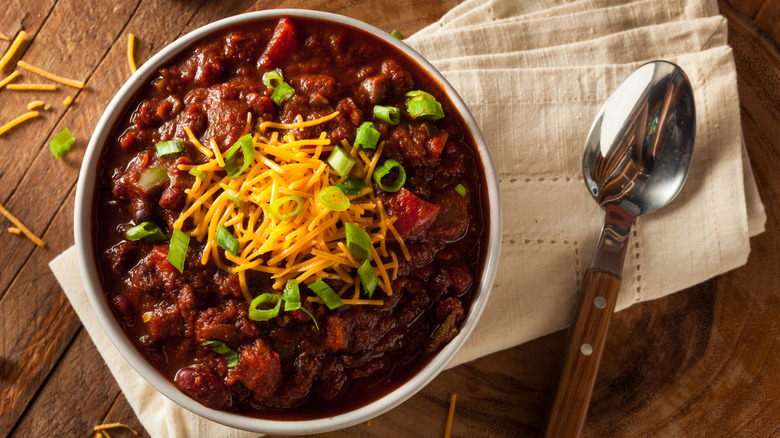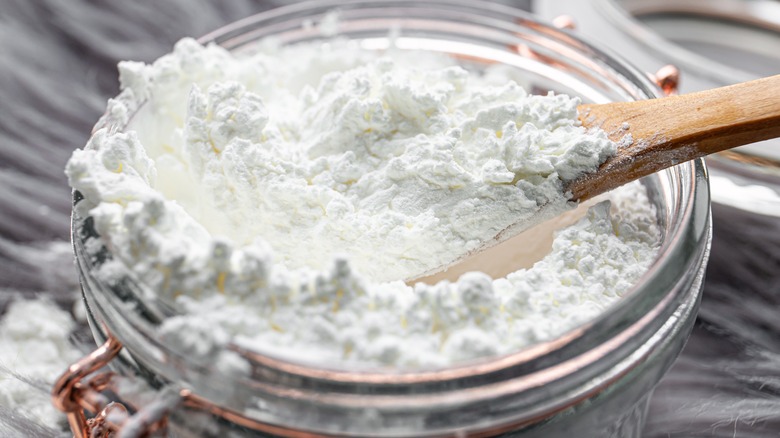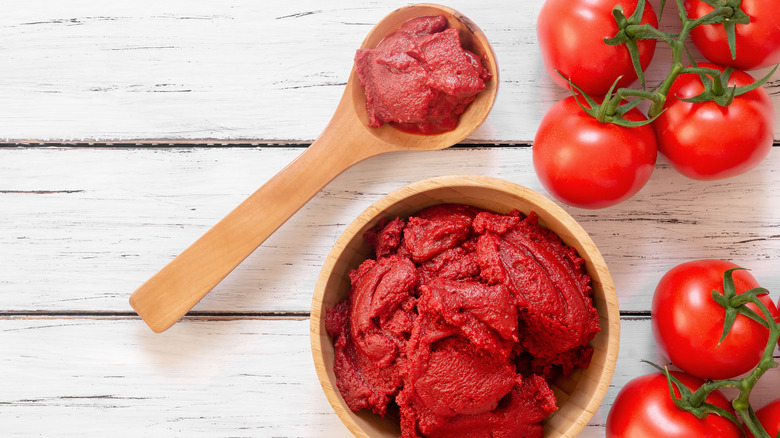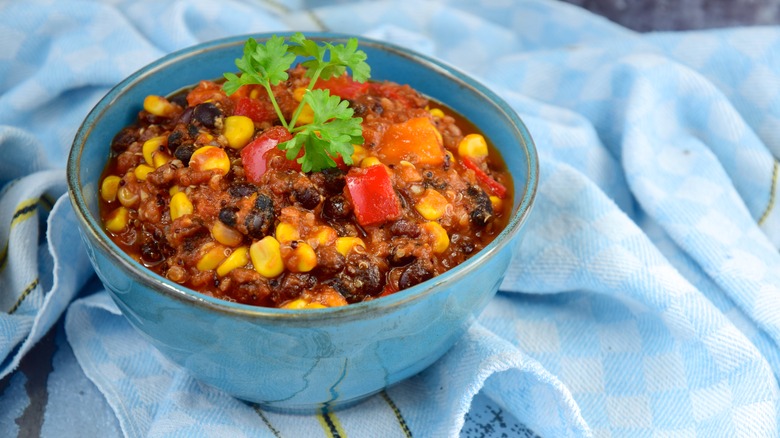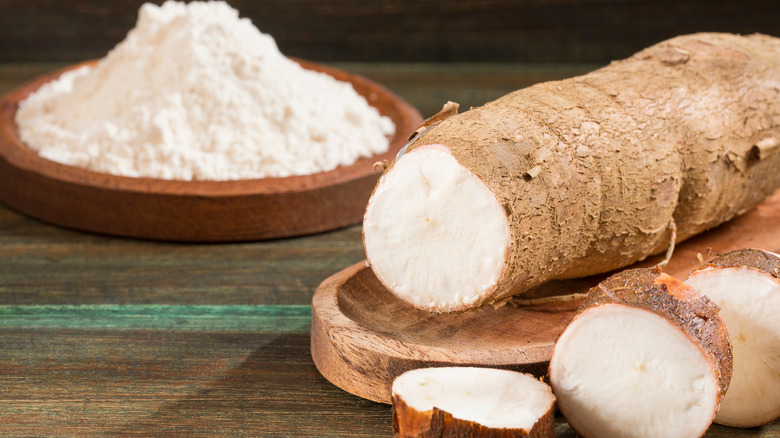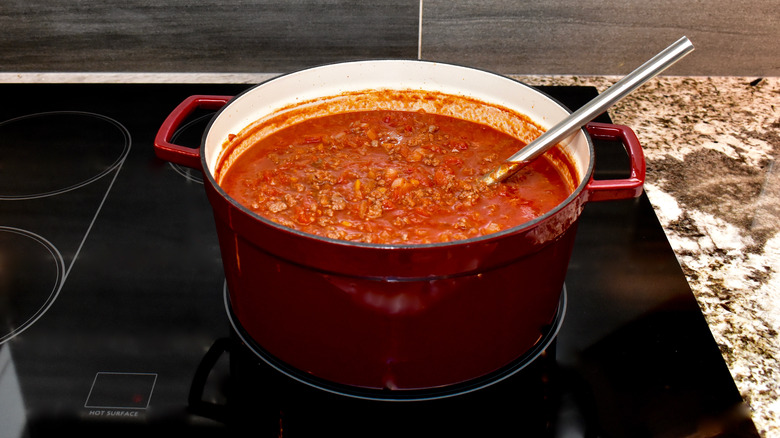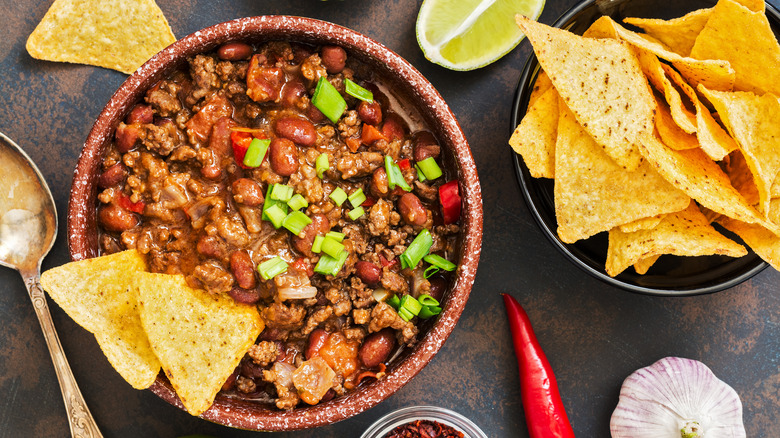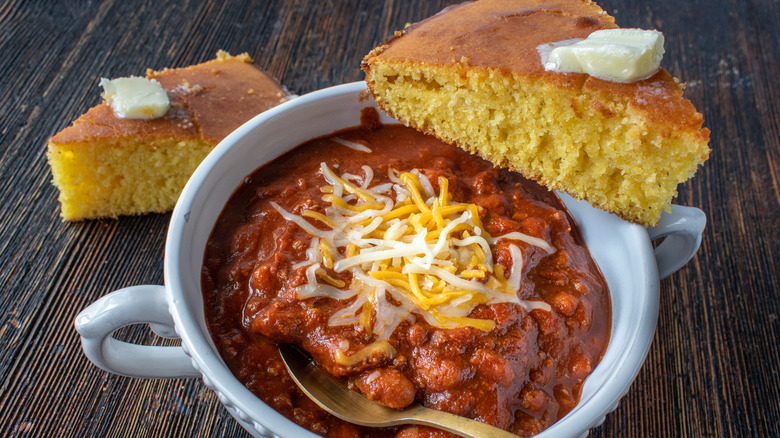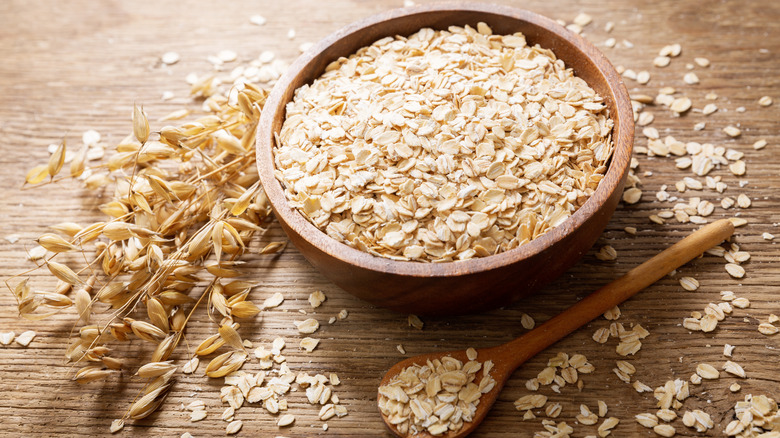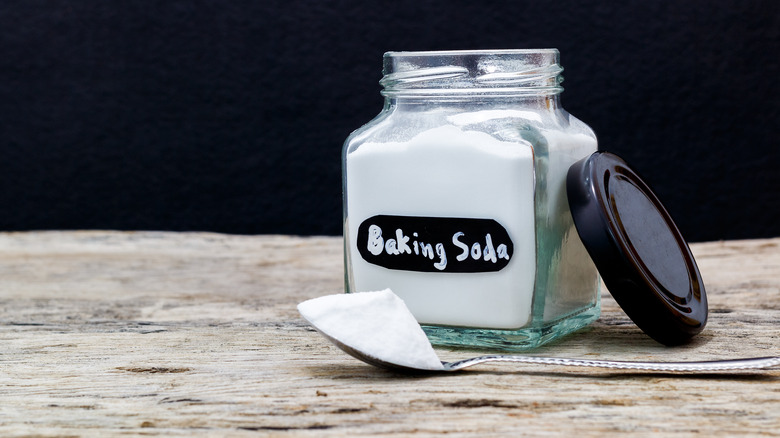12 Tricks For Thickening Your Chili
Chili makes for a fantastic meal, especially in the fall and winter. While there may be contention about what ingredients should go into the dish, with lots of regional American chili styles, everyone can at least agree there's nothing worse than making a mistake with your homemade chili that means it turns out watery and thin. According to MasterClass, there are a few reasons this could happen. Not cooking your chili for long enough is one of the primary reasons and may be the most likely culprit. However, things like using too much stock or too many fresh tomatoes can also cause problems. Fortunately, no matter the reason for your chili consistency issues, there are loads of ways to fix the problem.
We'll cover all the bases here so you can choose the one that most suits your needs, tastes, and the availability of items wherever you are. If you've already got a chili cooking on the stove that you're looking to thicken, you'll want a fix you already have on hand, and we have several of those. But if you're looking to invest in something that will make your chili extra delicious and as thick as you want it, consider picking up items the next time you're out shopping. That way you'll always have whatever you need to ensure your chili is everything you and all the guests at your table could hope for.
Add cornstarch or flour
Cornstarch and flour are traditional thickening agents. So how do you decide which to use if your chili needs thickening? According to On the Gas, there are a couple of things to consider. You will need different amounts of each, so what you have on hand matters. The temperature and time involved in using them successfully also differ.
The primary difference between the two is what they're made of. Cornstarch comes from corn, and flour comes from wheat. However, although they might look similar, you can't swap them out at a one-for-one value.
For the sake of flavor alone, cornstarch is your best option, as it's broadly flavorless, and it also has the benefit of being gluten-free in case any of your guests have celiac disease. But you can't just shake it over the pot and stir it into your chili. First, you'll need to create a slurry by mixing it with water. You'll need 1 tablespoon of cornstarch and 1 tablespoon of cold water for each cup of chili you're cooking. Mix these together and stir the slurry into the chili as it cooks (via Greengos Cantina). If using flour, that will also need to be turned into a slurry to work as an effective thickener. The only difference is, you'll need to use room temperature water instead of cold.
Mix in tomato paste
Another excellent way to add some heft and extra flavor to your chili is with tomato paste. Greengos Cantina explains you will need to factor in flavor if you opt for this thickening agent. It will give your chili a zesty taste that works well with meat and beans. But it will also give your chili a sweeter taste, so you must balance your other seasonings to account for that.
It may seem counterintuitive when we've already discussed tomatoes being a potential culprit in your too-thin chili, but that only happens with whole tomatoes, either fresh or canned. This results from the tomatoes releasing water into your pot of chili, which affects the consistency (via Dalstrong). You can use tomato paste from a tube, but if you're buying it to thicken your chili, opt for cans. You'll need to add an entire one to your pot of chili for this hack to be effective.
Once the tomato paste is added, let your chili cook for at least another 30 minutes. Doing so without the lid will also help your chili to thicken, as we will discuss later.
Put in some protein powder
According to Men's Health, you can add protein to dozens of recipes by stirring some powder into your meals. And while this option may be non-traditional, it has an added benefit. Several chili recipes call for chocolate, which gives a richer and darker flavor, and it's the secret ingredient that kicks Martha Stewart's chili recipe up a notch.
If choosing to use a flavored protein powder, go for a dark chocolate variety rather than milk chocolate since the latter tends to be sweeter and may negatively affect the taste. Dark, unsweetened, and Mexican chocolate works best to balance your chili flavors (via Foolproof Living). This works because it offsets the acidity that tomatoes and peppers give to your chili.
If you're worried about adding chocolate flavor, you could try adding an unflavored whey protein powder instead. You don't need to turn this into a slurry first and can just add it directly into the pot.
Add beans or other vegetables
Adding vegetables is another way to make your chili thicker. According to Kansas Beef, it's not just beans that make excellent additions to your dish, although those are the most common choices. You can use a whole host of vegetables including butternut squash, chickpeas, pumpkin, spinach, peas, zucchini, and carrots. Not only will this make your chili thicker, but it will also add nutrients. It's also an excellent way to sneak a bit of extra veg into your food if you have picky eaters at home. They'll never know you've packed the dish with all that goodness. You could even skip the meat entirely and make a vegetarian chili.
Using a potato masher can also help thicken your chili. Mashing your beans, squash, or other starchy vegetables helps to break them down, releasing starch that naturally thickens your chili. And while adding beans or vegetables to your chili will certainly affect its flavor, these additions can contribute to an even more delicious-tasting meal.
Try flavorless arrowroot powder
This option is a bit less conventional but easy to pull off. You can pick up arrowroot powder or arrowroot starch anywhere you buy Bob's Red Mill products, as well as in natural and health food stores, plus larger grocery stores. The good news is that, like cornstarch, it's flavorless, so you don't need to worry about altering the taste of your chili. It's also gluten-free, which is good news for your friends or family members with celiac disease or gluten sensitivity.
Like flour or cornstarch, you will get the best results with arrowroot powder by creating a slurry. You'll need to mix room temperature water with your arrowroot powder at a 2:1 ratio to make the slurry (via Jessica Gavin). Then add the slurry to your chili at 185 to 206 degrees Fahrenheit.
Keep an eye on your chili's temperature after adding the slurry. If you simmer it for too long after adding the arrowroot, this agent will lose its thickening capabilities, and you will have added it for nothing.
Simmer longer and cook uncovered
Want a simple fix for making your chili thicker? Try cooking it for longer. Keeping your chili simmering could be all it takes to turn things in your favor. Leaving it uncovered also helps. According to Martha Stewart, leaving the lid off while cooking allows moisture to evaporate, leading to a thicker chili. Allowing your chili to simmer without a lid also helps intensify the flavors.
This process has three levels: gentle simmering, simmering, and lively simmering (via Purely Cookware). For thickening chili, you may want to start with lively simmering. You will see bubbles similar to boiling, but they will be smaller. This will actively reduce the amount of liquid in your pot, creating the thick consistency you're looking for.
If you're making your chili in a slow cooker, you could accomplish the same goal by reaching a gentle simmer and letting it cook for longer. This will create steam and occasional bubbling and will cook over a longer period, enhancing the flavors and consistency of your chili.
Mix in masa harina or cornmeal
Masa harina is the ingredient you need for a thicker, more flavorful chili. What's the difference between masa harina and cornmeal? Mostly the preparation. According to Mexican Please, dried corn is used as the base agent for both. The corn is soaked in an alkaline substance that removes the skin. It can then be ground into masa dough. To make masa harina, the dough is dehydrated and turned into a flour of sorts. Both cornmeal and masa harina will thicken your chili, but masa harina will also provide a distinct corn flavor often associated with taco shells and corn tortillas.
This is one of the best and easiest ways to both thicken and add flavor to your chili. It's also easy to come by. You can get it in Latin markets, big box stores, plus specialty grocers like Sprouts may sell it from bins, where you can buy it in smaller amounts.
Using masa harina as a thickener can also add nutrients to your cooking. It has higher magnesium and fiber than wheat flour and it also contains niacin and vitamin B. Niacin has a host of reported health benefits, including helping to regulate cholesterol, reducing inflammation associated with arthritis, and helping with DNA repair and brain function.
Add corn chips or tortillas
Some say the best way to thicken up chili is to add crushed corn or tortilla chips. This works because the chips will absorb some excess moisture in your chili. It also adds crunchiness to your dish, creating a texture that can make it seem thicker, even if it isn't.
Tortillas will also work to thicken your chili the same way they thicken tortilla soup (via The Takeout). This works exceptionally well with stale tortillas, and it's a wonderful way to use them up if you have some left in your pantry. You can start the process by toasting them, particularly if they are pretty stale. If they aren't that old, this step may not be necessary.
Once your tortillas are toasted, tear them up and place the pieces in a bowl. Cover them in some of the liquid from your chili and allow the tortillas to absorb the liquid. Put them in a blender or a food processor and turn them into, you guessed it, a slurry. Once you've done so, stir the slurry into your chili to thicken it. Like using masa harina, this will also contribute flavor to your chili.
Crumble in crackers or cornbread
This idea follows the same principle — add some crackers or crumbled cornbread over the top, which will absorb moisture and help thicken your chili. The Culinary Pro explains that adding bread as a thickening agent is an age-old practice. You could achieve similar results with breadcrumbs or any stale bread you may have on hand.
Homemade breadcrumbs are your best option if you choose this technique (via Greengos Cantina). Just be careful you don't use too many. An alternative to stirring them into your chili is to sprinkle them over the top, where they will create a crust of sorts. Cornbread can be used in this same way. There are dozens of recipes for chili with cornbread crumble, toppings, biscuits, or dumplings that will enhance your chili's texture, and you could even go as far as turning your chili into a cornbread casserole.
If you choose to add crackers instead, go with whatever variety most appeals to you. You can use saltine crackers, buttery crackers, or flavored options like garlic. You can mix these into the pot while cooking and allow them to dissolve for a thick chili (via InsanelyGoodRecipes). Or sprinkle them over the top when serving and let your friends and family decide whether to stir them in or leave them as a topping.
Add whole or ground oats
If you don't have any bread on hand, you should start adding oatmeal to your chili. Regular or quick oats will work. This is similar to using bread as a thickener but works wonders if you don't have any. Simply substitute half a cup of oats for every slice of bread. You can use them whole or grind them into oat flour using your food processor (via The Recipe Link). And this is safe to use in chilis for your gluten-sensitive friends and family who can't consume flour and starches (as long as you use gluten-free oats).
The fastest way to implement this hack is with quick oats (via MasterClass). It only takes 1 tablespoon and three minutes. The oatmeal will absorb the excess liquid in your pot, thickening it. If you know you have issues with chili being too thin, you can put the oatmeal in right from the start (via Pop Sugar). Add half a cup to a cup of old-fashioned oats in the crockpot with your other ingredients. You may want to use less with quick oats because they absorb so much liquid.
The oats will absorb the flavor of the chili, so you don't have to worry about your chili tasting like oatmeal.
Increase flavor and thickness with cheese
According to Real Meal Evolutions, there are dozens of ways to use lactose products to thicken soups, sauces, and chili. Cheddar and Parmesan have wonderful umami flavors and will work as perfect thickening agents in your chili. Instead of just using cheese on top of your chili, consider mixing some in to thicken things up. If you really want to boost that umami flavor of your chili, fish sauce is an unexpected ingredient that will take it up a notch, too.
Stirring shredded cheese into your chili works as a thickener because cheese is an emulsifying agent (via Greengos Cantina). If you're a cheese lover, this is one of the tastiest ways to thicken your chili.
You can also use cream cheese as a thickening agent (via Quick Easy Cook). The easiest way to do this is to create a slurry of sorts from the cream cheese and chili. Stir some of the hot liquid from your pot of chili into a bowl of cream cheese. Once the two are incorporated, stir the mixture back into your pot of chili. Give it about 15 minutes to thicken.
Use baking soda and salt
There's a secret ingredient that you should be using in your chili to make it wonderfully thick — and it's baking soda. It will also enhance the flavor of whatever you choose as the best type of meat for your chili.
Using baking soda in your chili helps your meat retain its moisture, and is a super ingredient that will take your chili to the next level. Unlike the other hacks in this article, you don't add baking soda and salt into your chili as it cooks, you use it as a tenderizer for your meat before cooking. Mix ¾ of a teaspoon of baking soda and 1 ½ teaspoons of salt for every 2 pounds of meat you're cooking. Mix this with 2 tablespoons of water and use it on your meat before putting it in your chili. Let it soak for 20 minutes. This will work on both ground and non-ground meat.
Before adding it to your pot, make sure you briefly rinse the meat. This prevents any residual baking soda and salt from adversely affecting the flavor of your chili. For the best results, use lemon juice to neutralize the effects of the baking soda and salt, then rinse and add to your other chili ingredients. This will make your chili delicious, tender, and thick.
